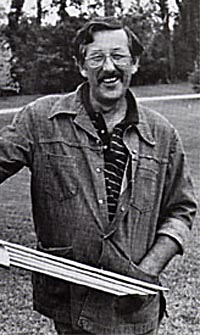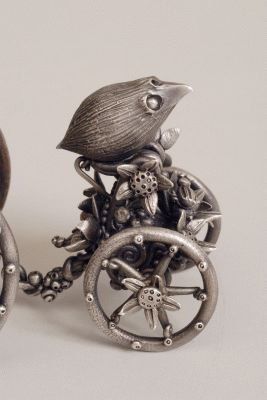L. Brent Kington: Mythic Metalsmith
Topeka to Toys
Kington's metalsmithing experience began at his Topeka, Kansas, high school (1949-1953), where he benefited from the unusual experience of having an art teacher, Fabion Wolf, who taught jewelry classes. Along with design-related art classes, Kington also focused on painting and drawing — earning numerous 'Gold Key' awards from the nationwide high school Scholastic Art Awards Competition. Fabion Wolf would see that Kington had a full scholarship to attend the summer art program in jewelry and design at the University of Kansas in Lawrence — an 'eye-opening experience' where Kington met university students and teachers engaged in the same program.
Kington credits great instructors and good friends for his success at the University of Kansas at Lawrence — Eldon Teft, his primary sculpture instructor; Carlyle Smith, his primary metalsmithing instructor; Evie DeGraw, a weaving instructor; Robert Montgomery, a graduate student and instructor whose friendship included taking Kington to operas, theaters, and museums; and Bob Moore, an student in architecture who shared with Kington drafting techniques and ideas of architectural design.
A strong interest in product design led Kington to refine his drawing skills in order to produce strongly rendered product-design images. Even though Kington became very adept at sophisticated product design drawing, he continued cartooning for 'fun,' as he had throughout his youth. This led to his creating cartoons for the campus humor magazine and later becoming the art editor for the school newspaper. By the time Kington was ready to graduate, he was only one class away from declaring an area of concentration that would define his Bachelors of Fine Arts degree — product design, sculpture or metals. He chose metals and graduated from the University of Kansas in the spring of 1957.
After graduation, in the summer of 1957, Kington pre-empted the inevitable military draft by joining the Army Reserves for a two year commitment. This allowed him the to stay close to his family's home in Topeka and to his ailing father. While serving out his two years, Kington maintained his earlier friendship with and visited his former college instructor, Robert Montgomery, who continued to encourage Kington to attend graduate school. In particular, Montgomery encouraged him to attend the legendary Cranbrook Academy of Art in Bloomfield Hills, Michigan (outside of Detroit). By the summer of 1959, Kington had married and moved to Michigan to attend graduate school at Cranbrook. Prior to leaving Topeka, Montgomery gave him tools and materials, including silver, left behind in Montgomery's classroom.
At Cranbrook, Kington studied under the strict regimen of Richard Thomas, every day, all day working on assignments and performing bench work. Thomas was an essentially self-trained metalsmith who came to Cranbrook in 1946 to study painting under Zoltan Sepeshy. Before completing his 1948 degree, Thomas experimented in the metals shop — enough to be offered the metals program director position by Sepeshy, who had become the college's director. Under Thomas, Kington was encouraged to complete a full investigation of experiments with materials toward developing “process” techniques. Kington credits Thomas with pushing him to take chances and to pursue “ideas.”
While on summer break from Cranbrook in 1960, Kington created the “little bird form” cast in sterling silver, working at his kitchen table. The “little bird form” would serve him well over the next 15 years in particular, reappearing throughout his toys, in larger bronze castings and eventually evolving anatomically into a human-like caricature. The low cranium slope of the forehead remains the same as the bird but the beak becomes a nose, often an exaggerated nose, one that Kington describes as his own.
When Kington moved in 1961 to Carbondale, Illinois, to head up the metalsmithing program at the Southern Illinois University School of Art, he recognized that his new rural location away from urban galleries might decrease the chances of getting exhibitions for his work, so Kington focused on creating cast sterling silver toys as play items for his children at home.
The toys gave Kington a platform to develop ideas of play and fantasy, and pieces that invited participation. An early cast silver candlestick (Bell, Whistle, and Candlestick, 1963) develops upward with a bell serving as its base, followed by a bird, which is a whistle, sitting on a perch just below the top cup, which is meant to hold a candle.
The Baroque Pull Toy (1968) is a wheeled carriage for several of Kington's caricatures and has linked appendages in front and behind the carriage with a bird that moves up and down when the carriage is pulled. The immensely detailed and embellished pull toy not only plays with a baroque sensibility, it also makes apparent the richness of Kington's skills and imagination.
Giving his toys textured surfaces was one way to satisfy Kington's strong dislike for the buffing and polishing time typically associated with the finishing process on cast silver objects. Employing surface textures was also another way of exploring a progressive interest in patinas, decoration, embellishment and ornamentation. Small item details are found throughout Kington's toys, some of which embellish the surface with happy sunflowers, organic tendrils, miniature droplets, and tiny hands and feet. Humorous creatures are poised for action as they set atop three-wheeled vehicles made for action.
Movement and implied motion is apparent in Kington's toys, whether a soldier charging forward on a rocking horse in Rocking Horse, 1970, or a little bird peaking out the end of a cannon made mobile by four solid wheels and a tow hook in Cannon, 1968).
His tricycle with a rider (Tricycle, 1965) evolves into a dragster with rider (Dragster, 1969) and again into an air machine and driver (Air Machine, 1970). The air machine is equipped with wings and propellers suggestive of a desire for flight.
No doubt Kington derived much joy in creating the toys for his children. When Kington finally decided to show the toys in a gallery setting, he found they were received with much enthusiasm and sold readily.
Read the essay by Jeannine Falino entitled "L. Brent Kington: The Lyrical Gesture in Iron" as a PDF document.





